
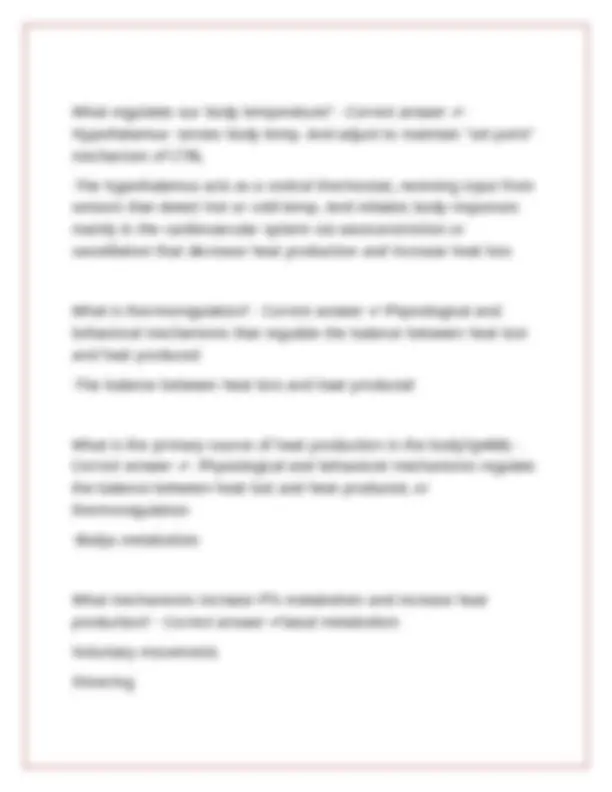
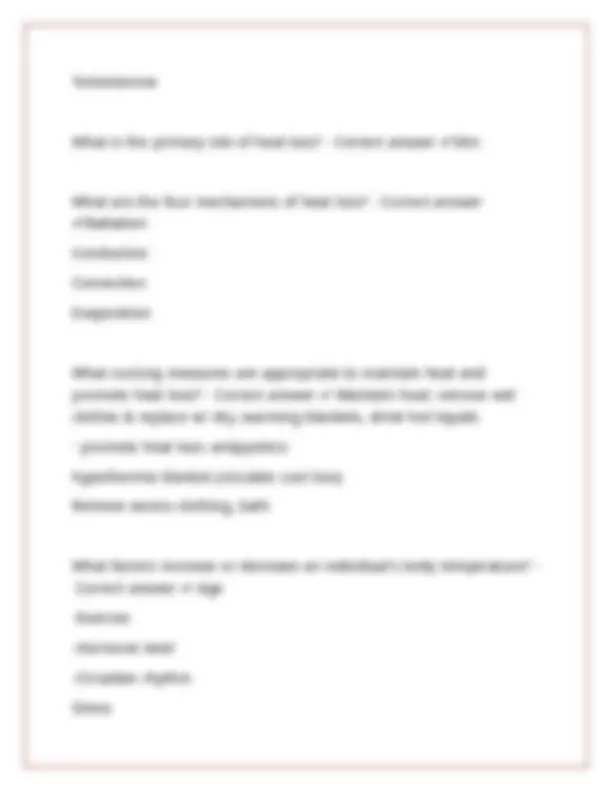
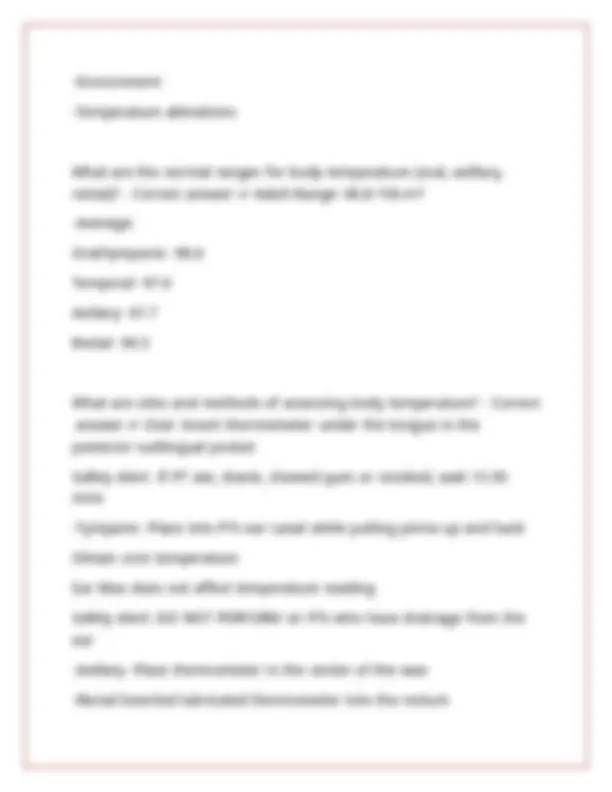
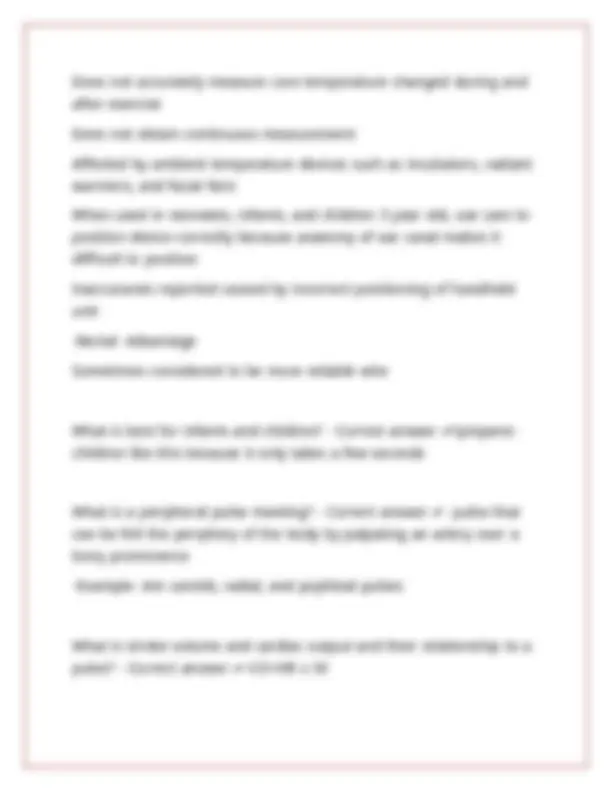
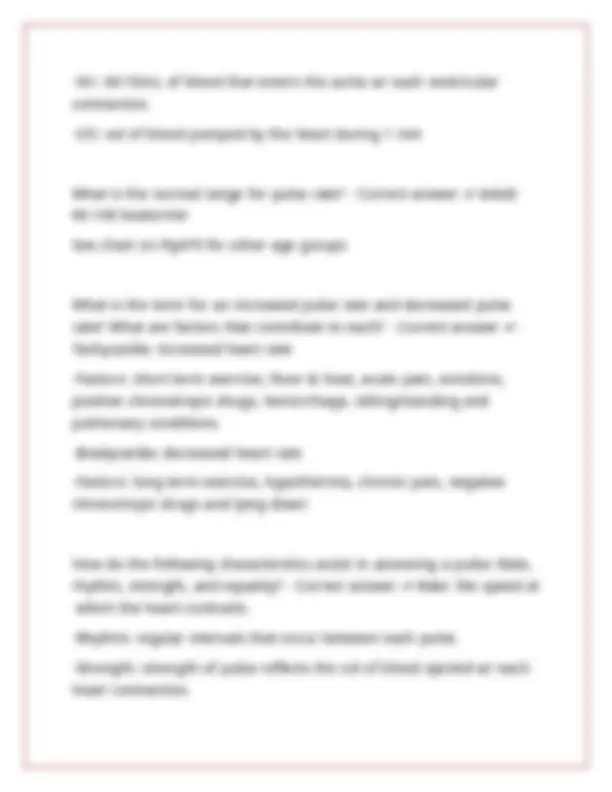
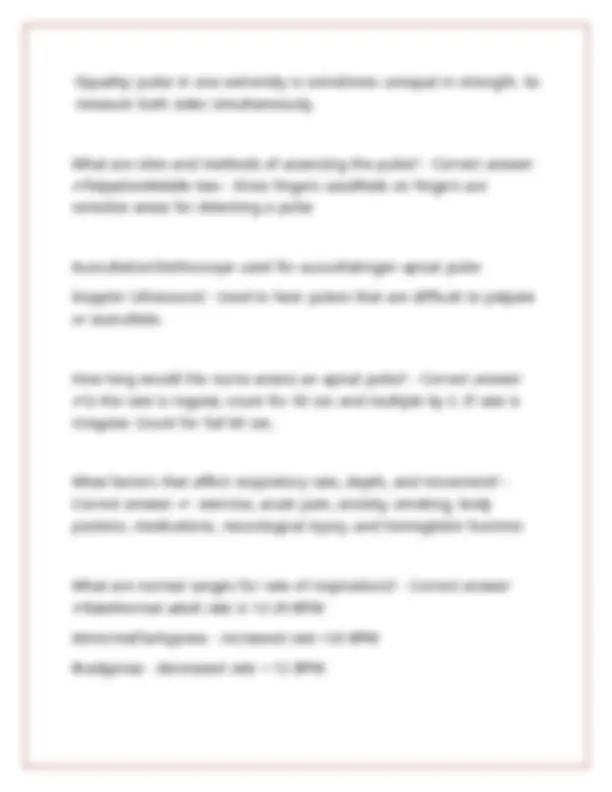
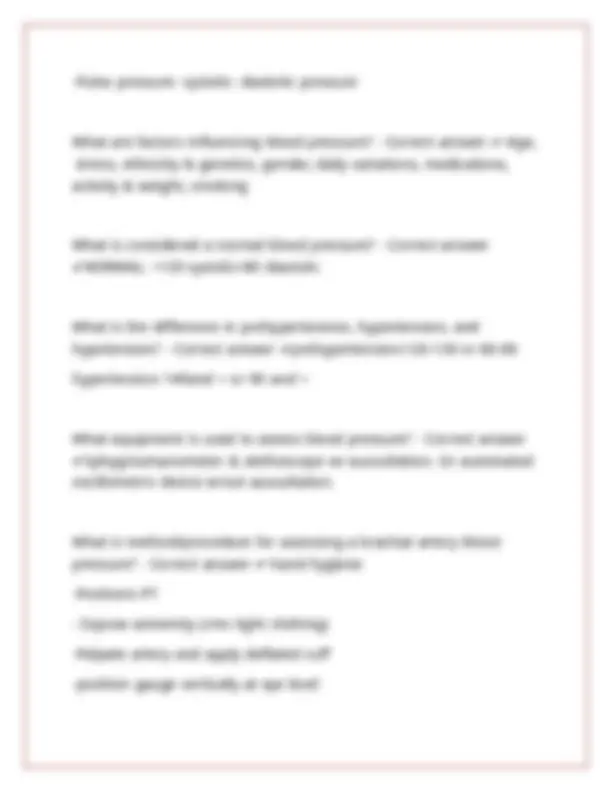
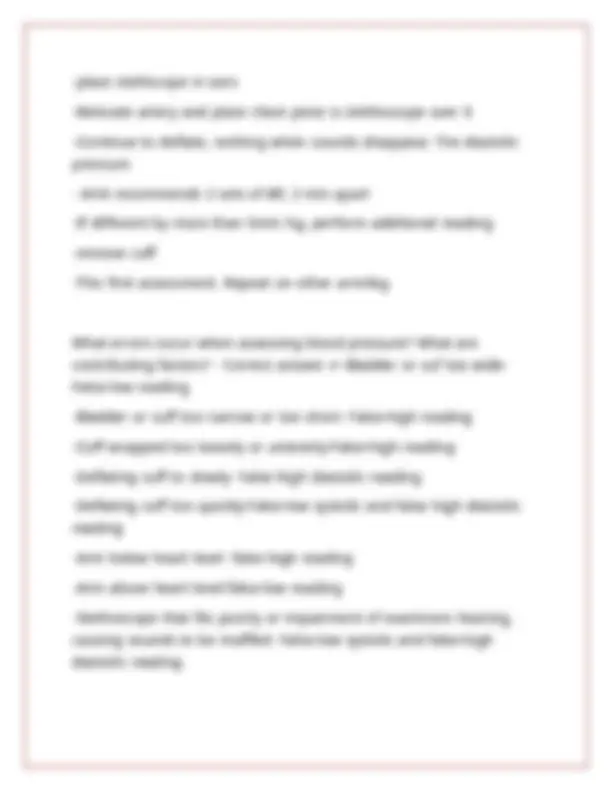
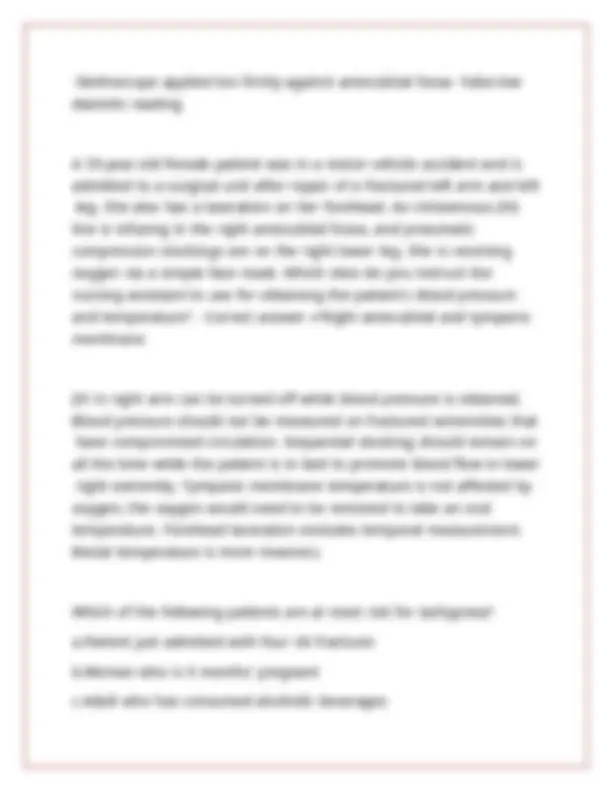
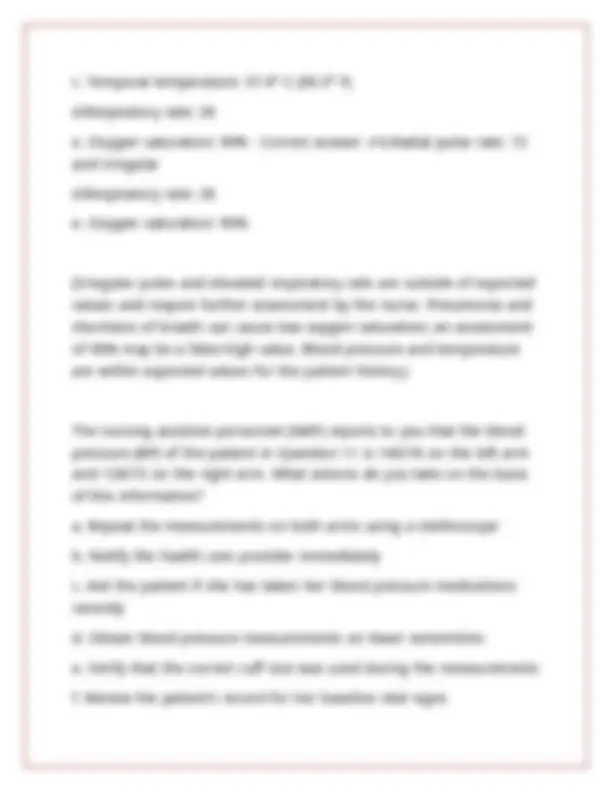
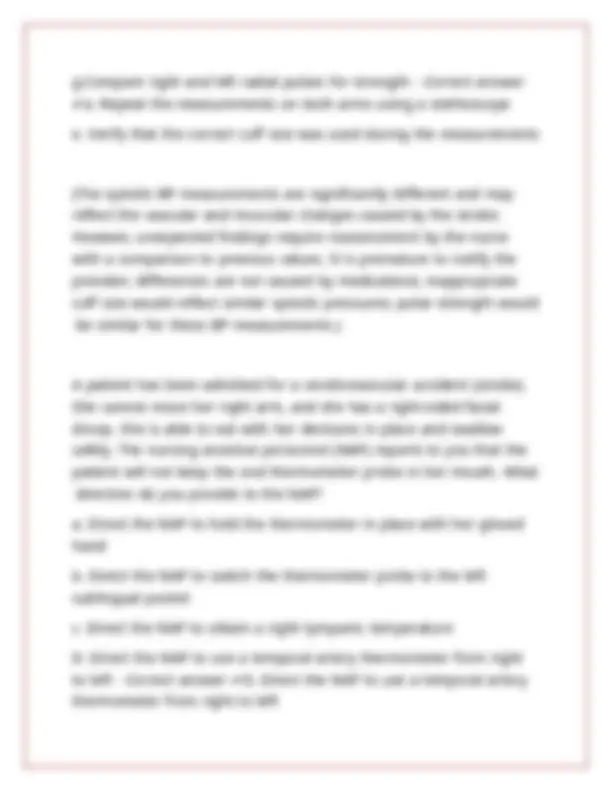
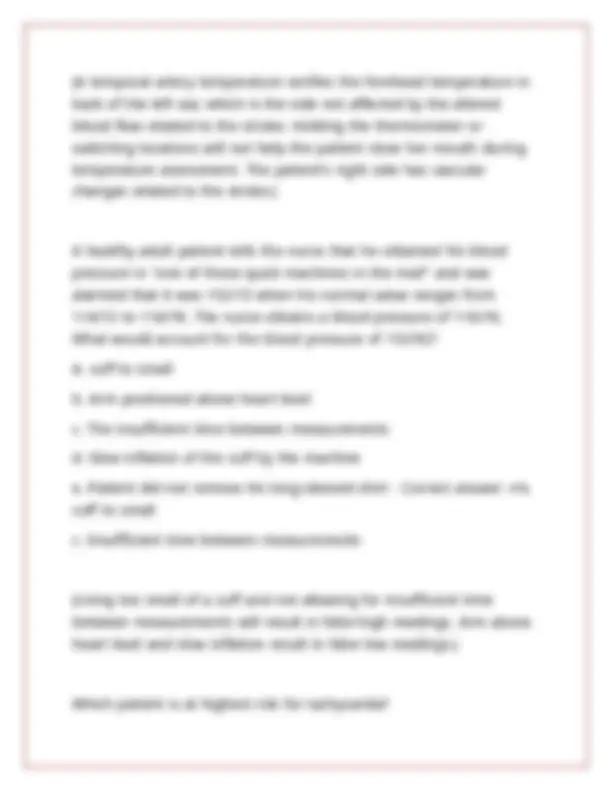
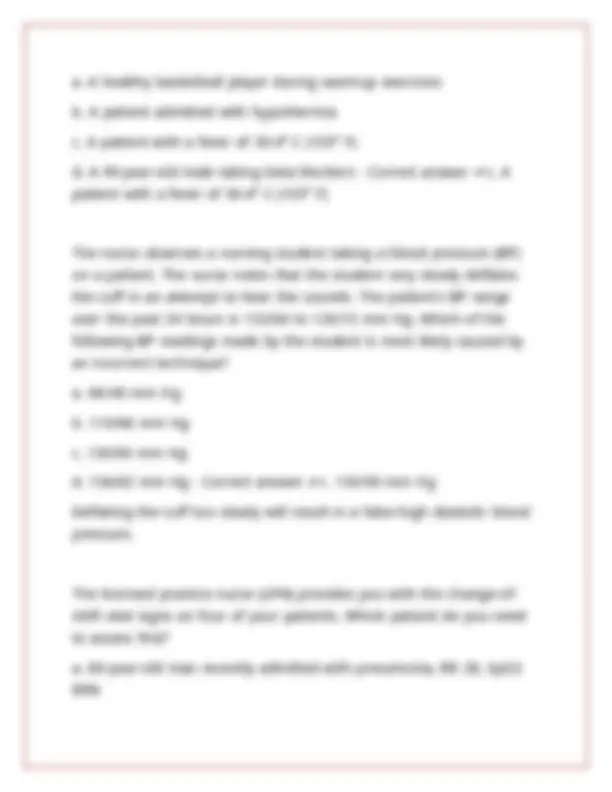
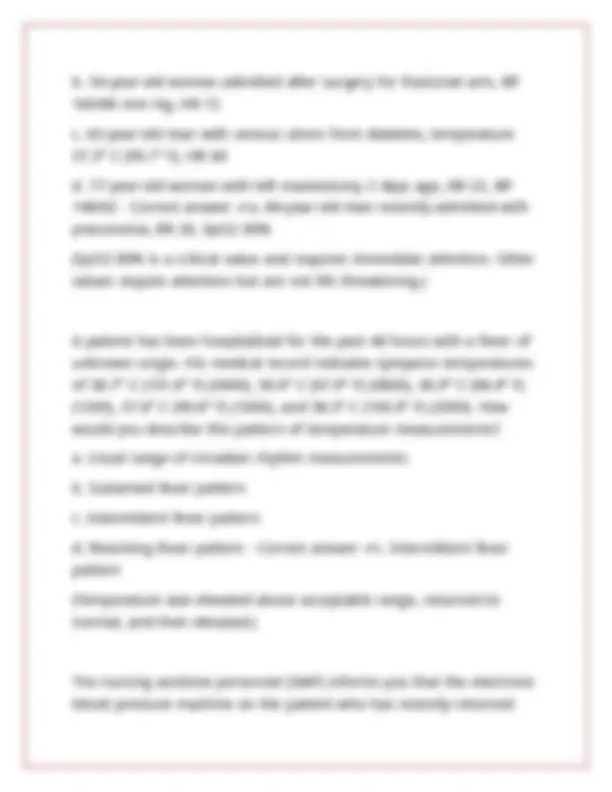
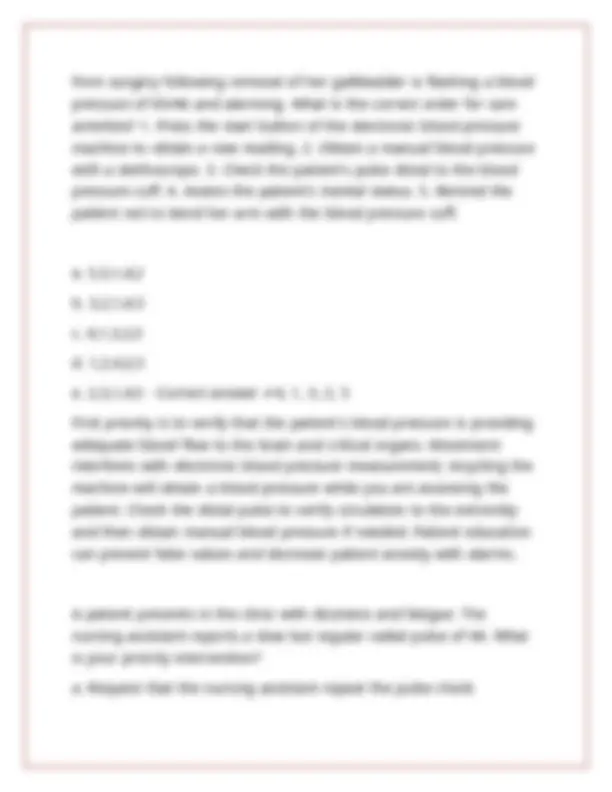
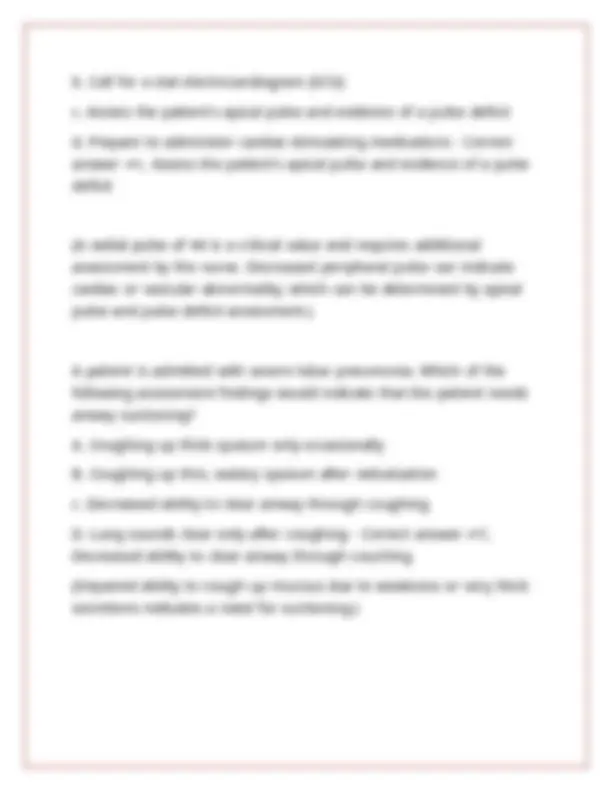
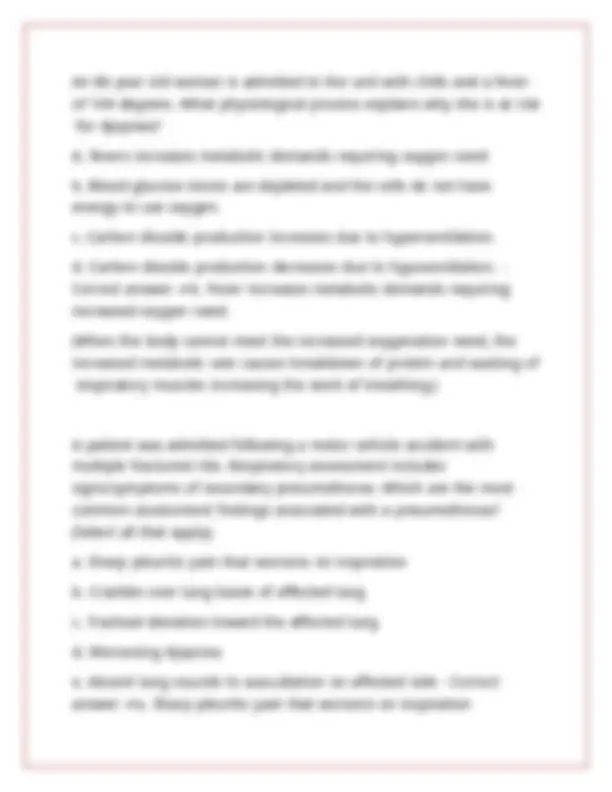
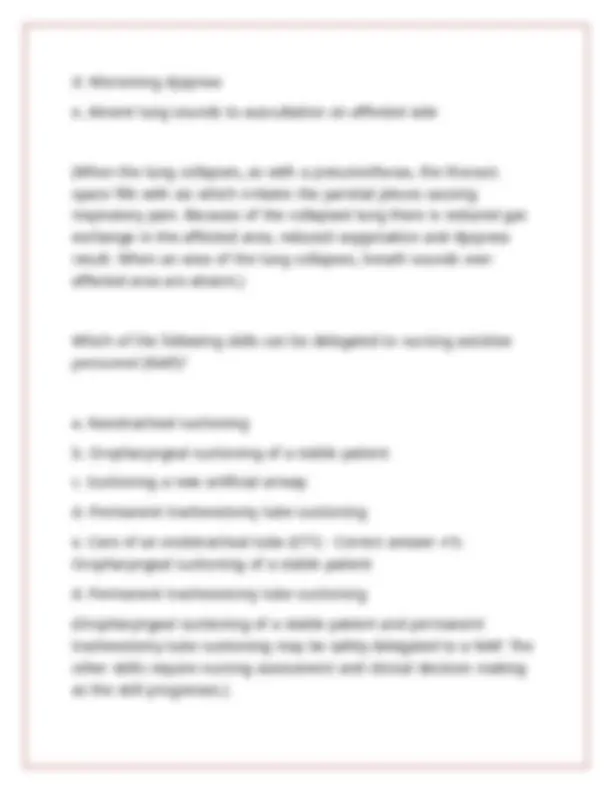
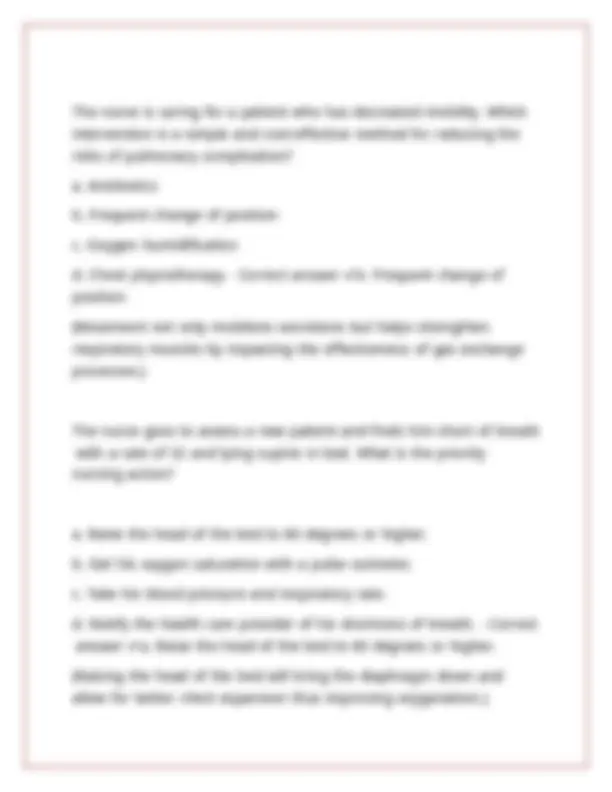
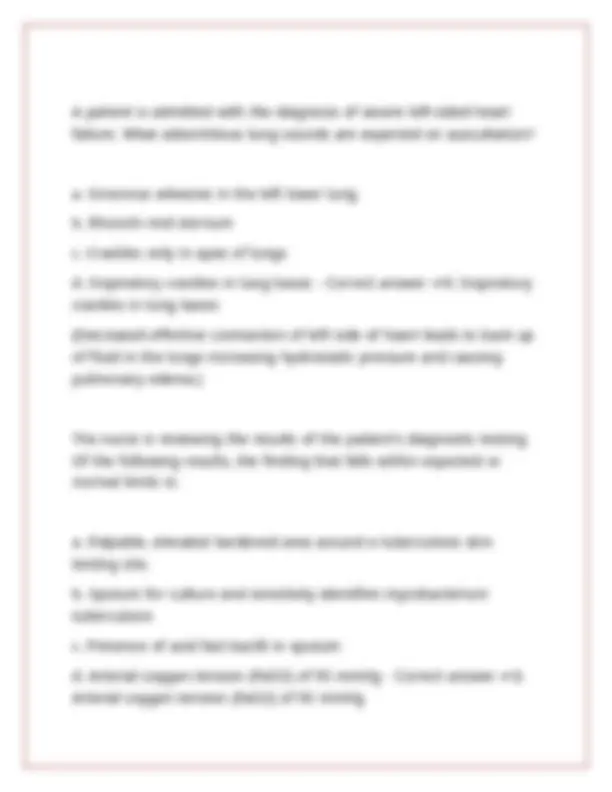
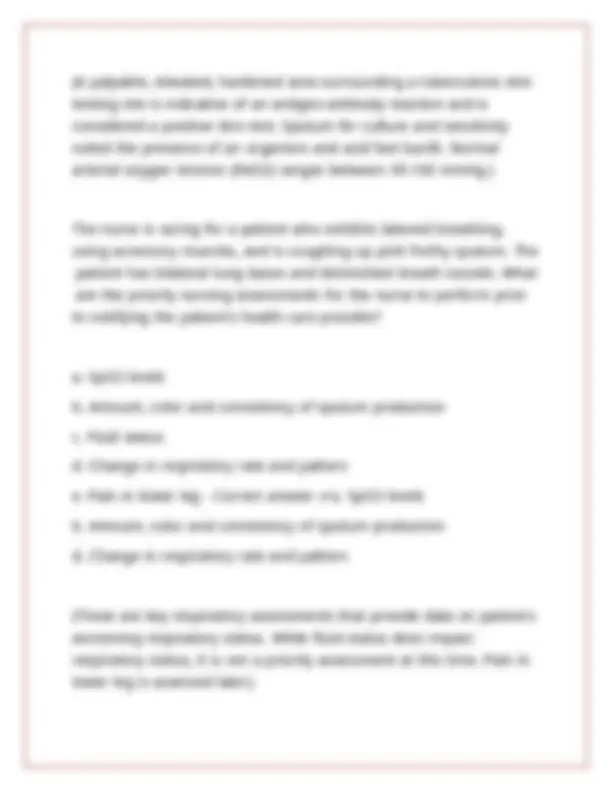
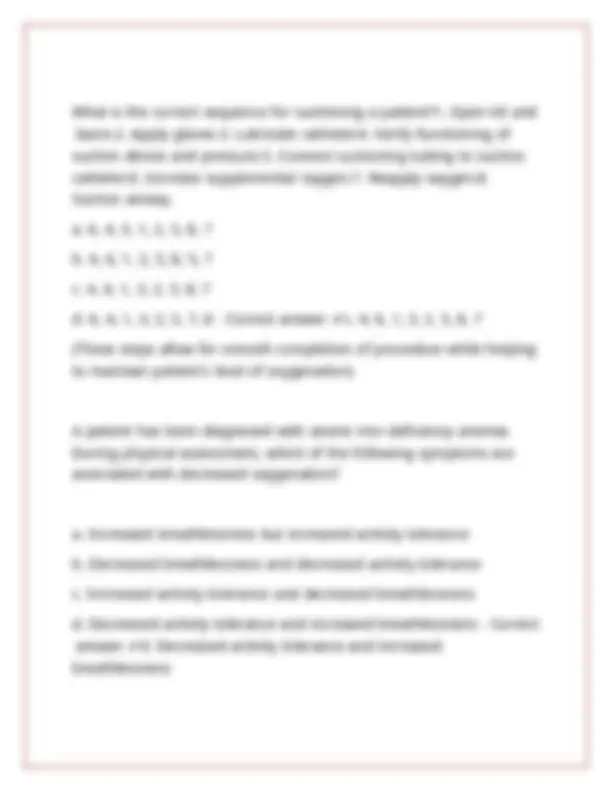
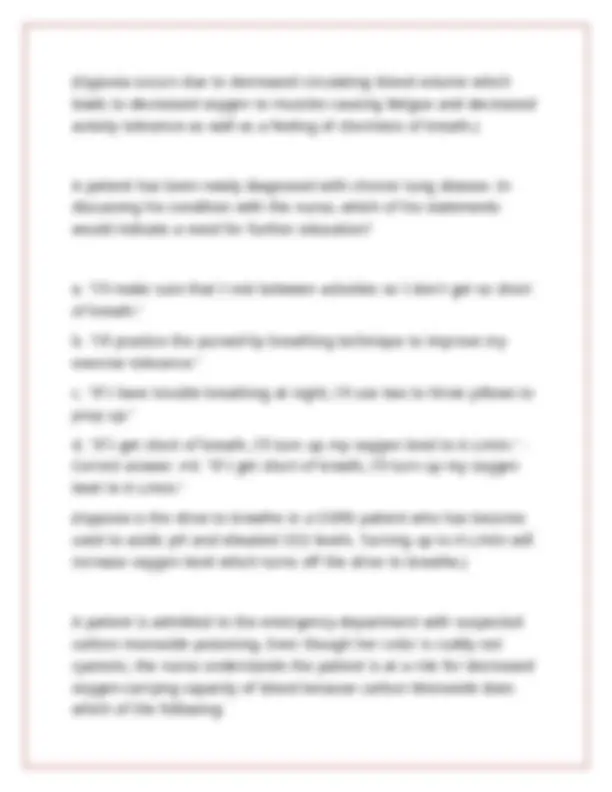
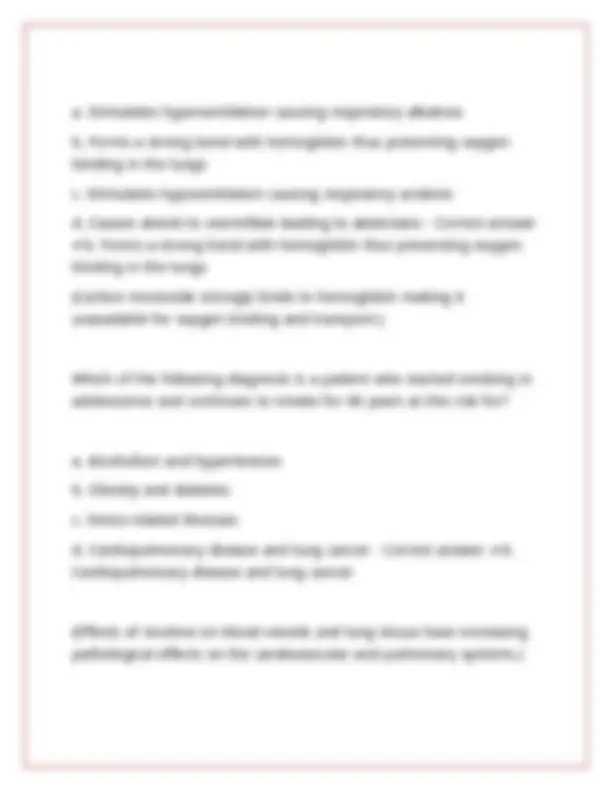
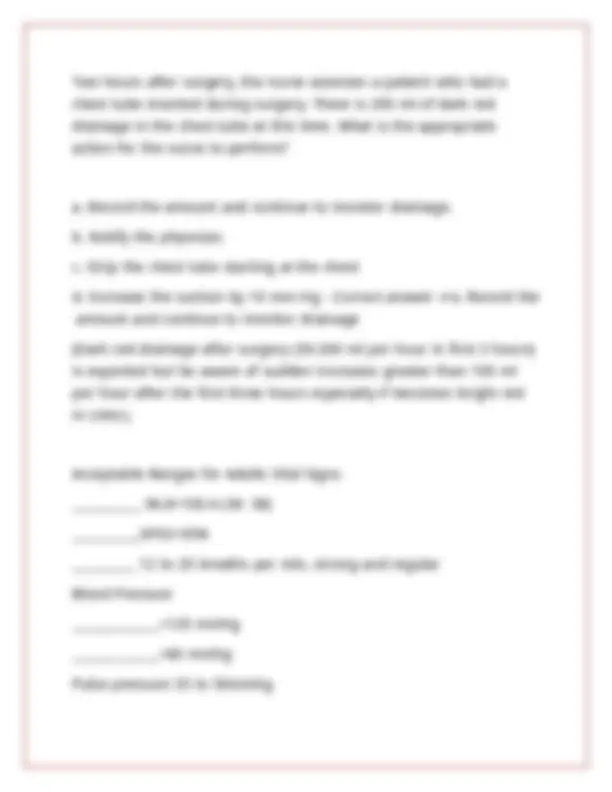
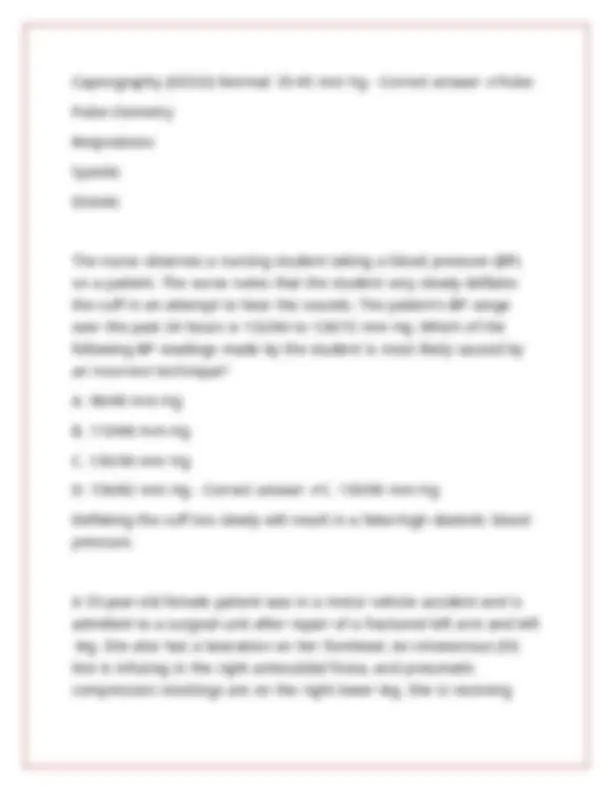
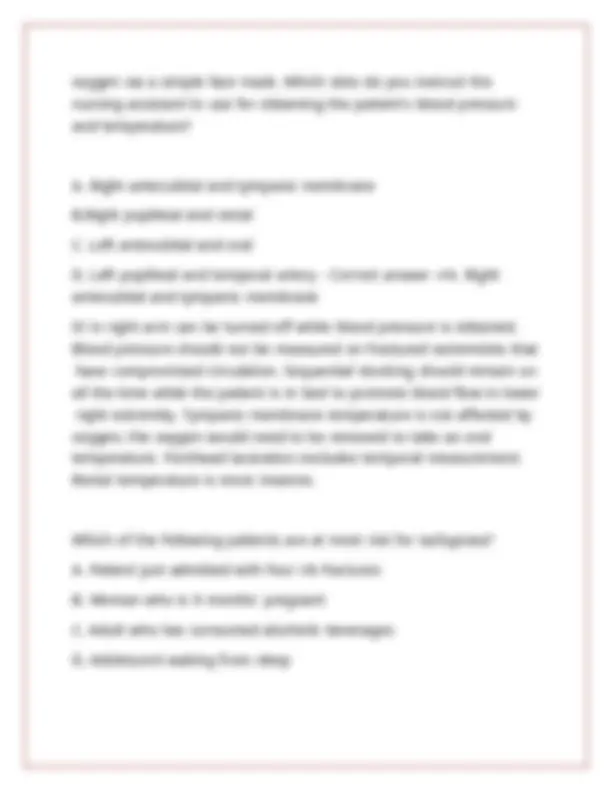
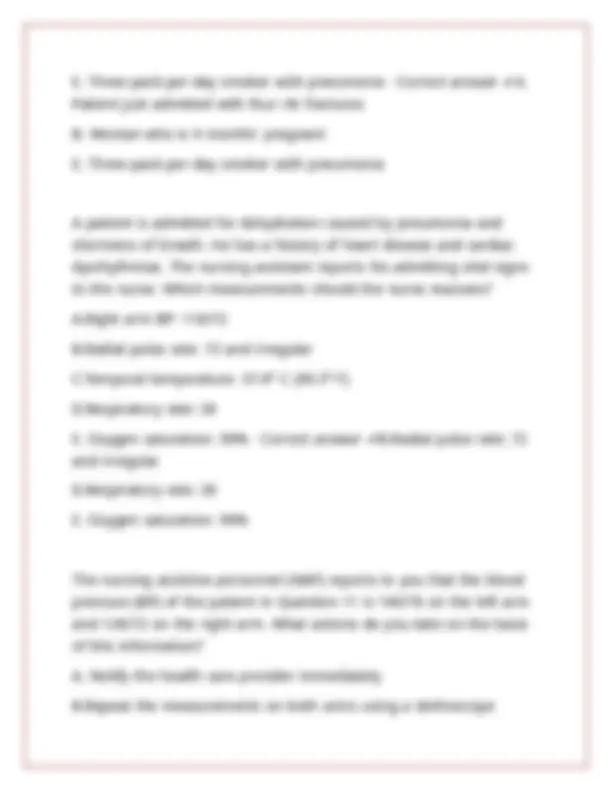
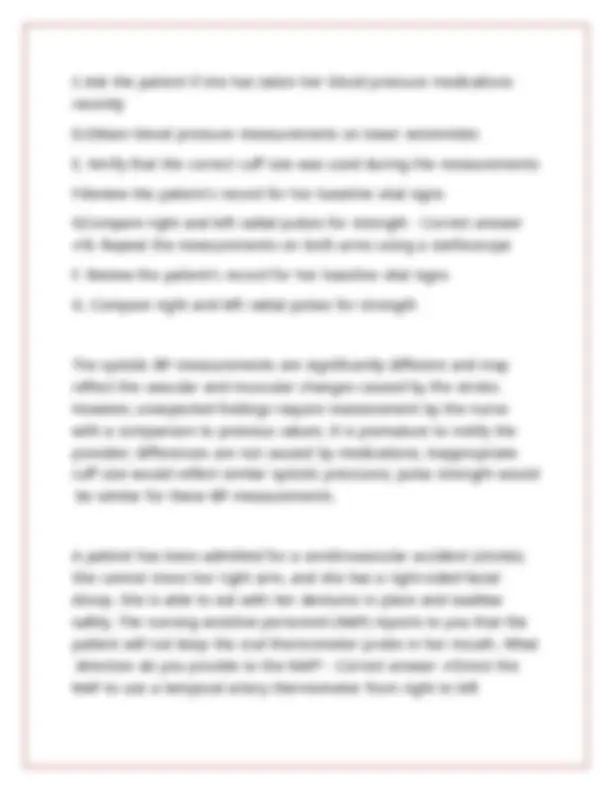
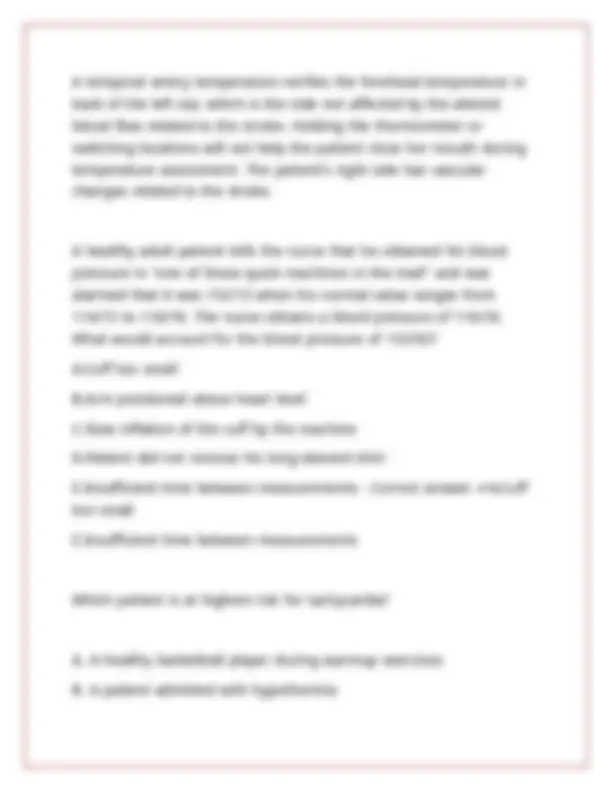
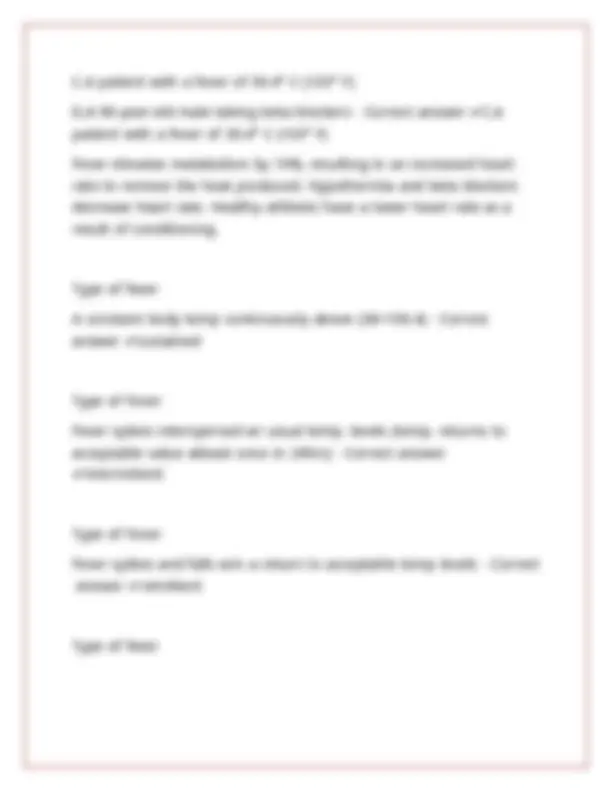
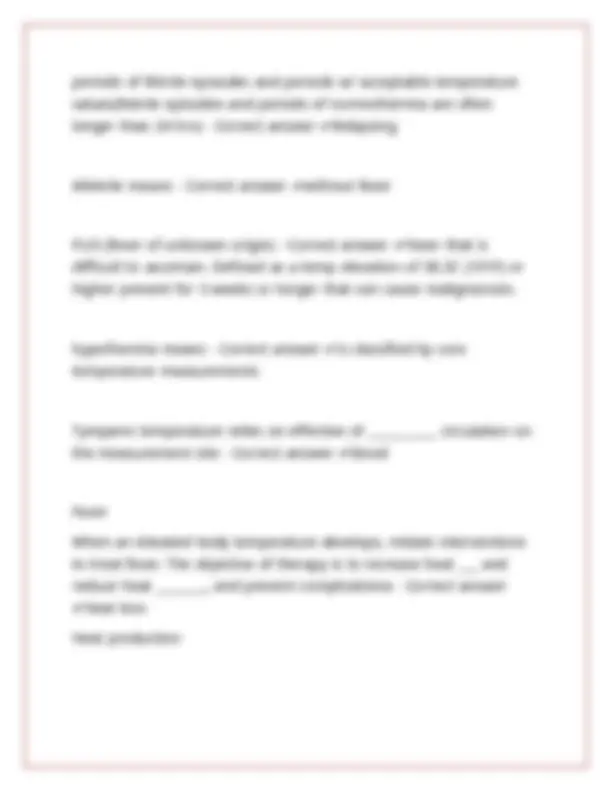
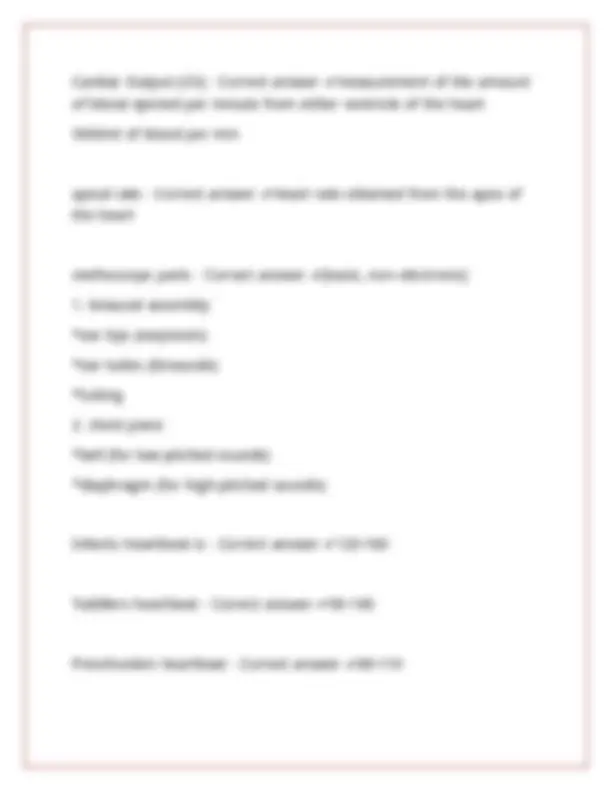
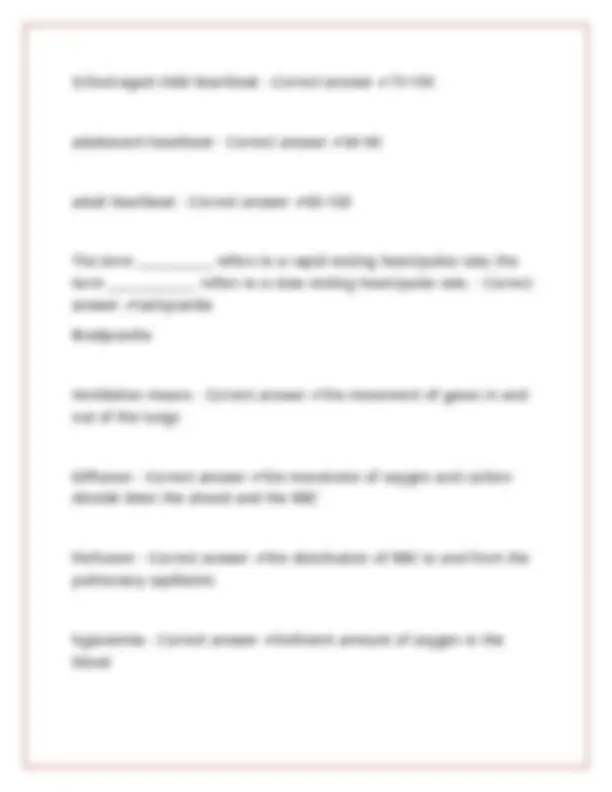
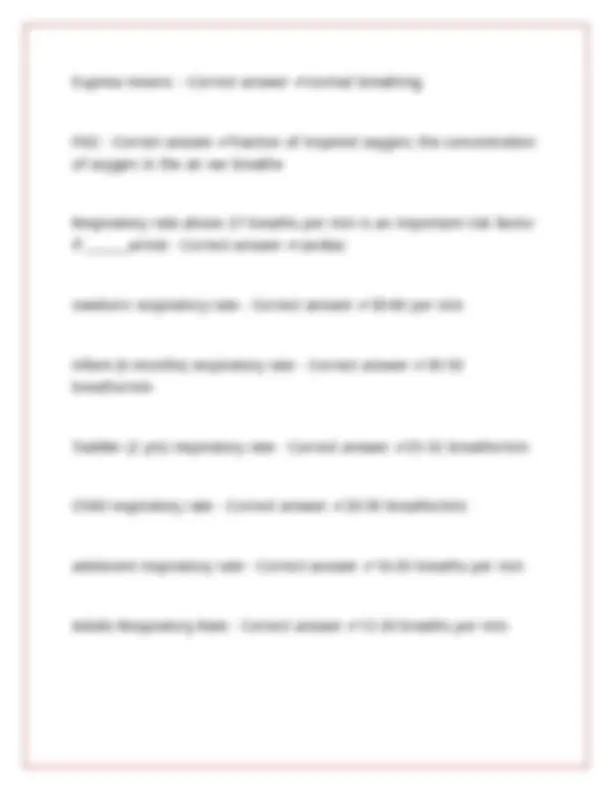
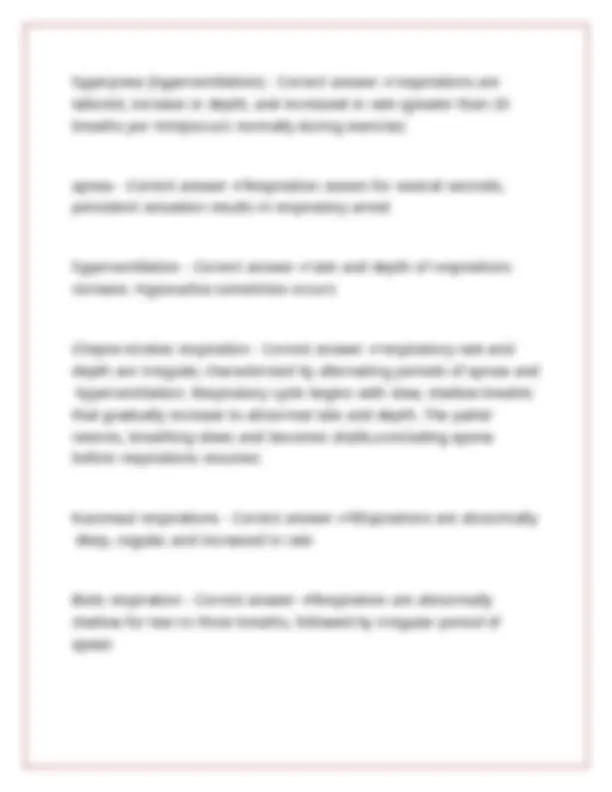
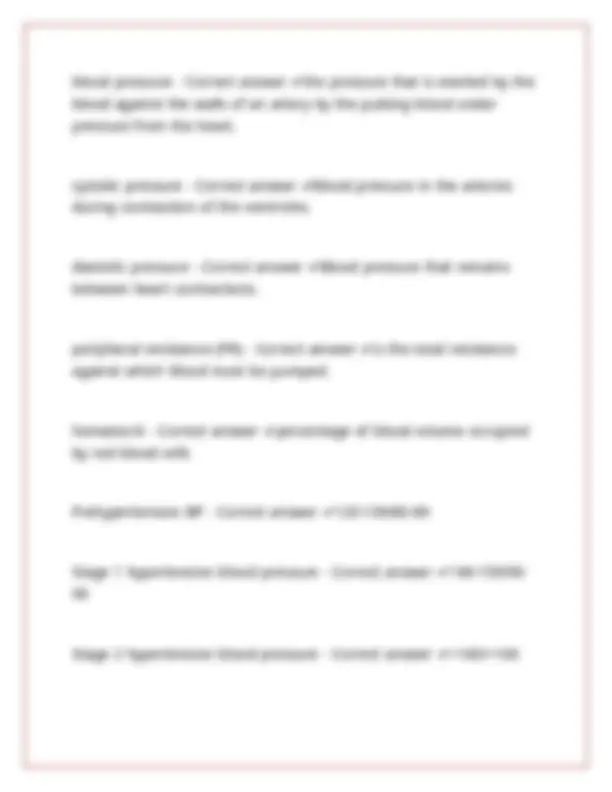
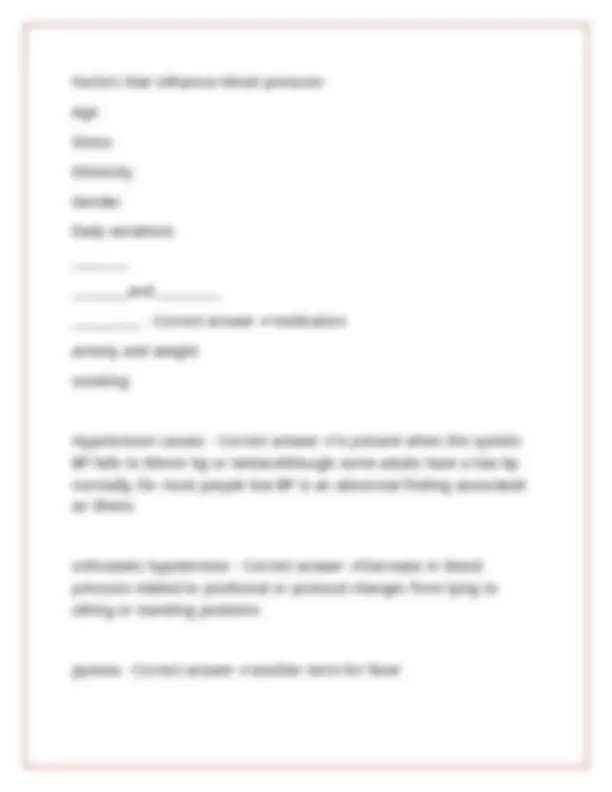
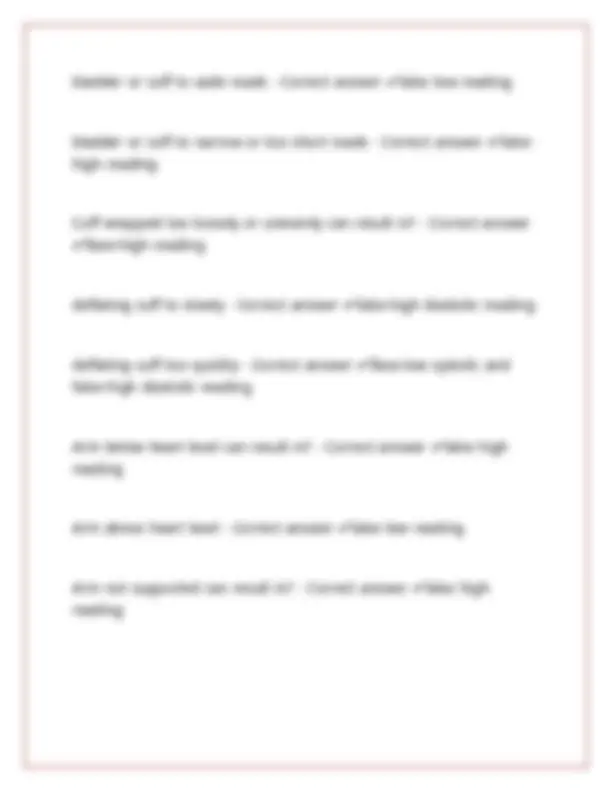
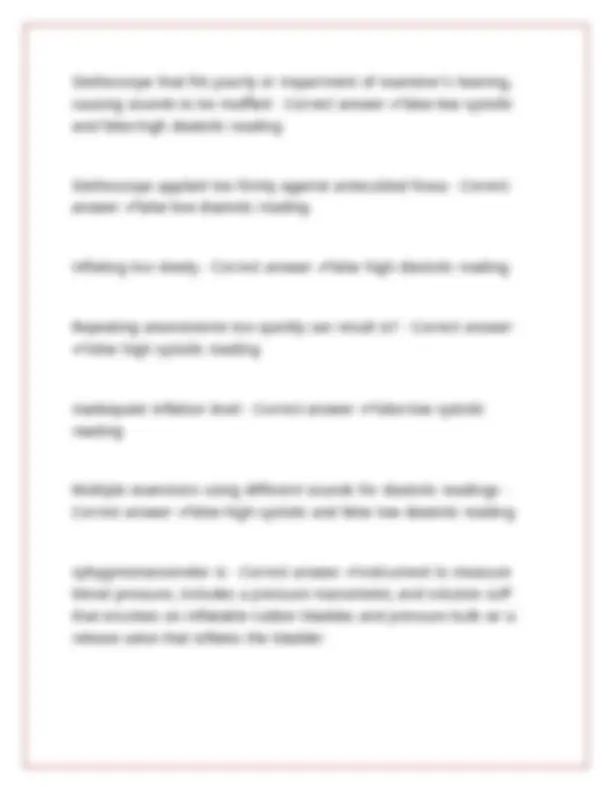
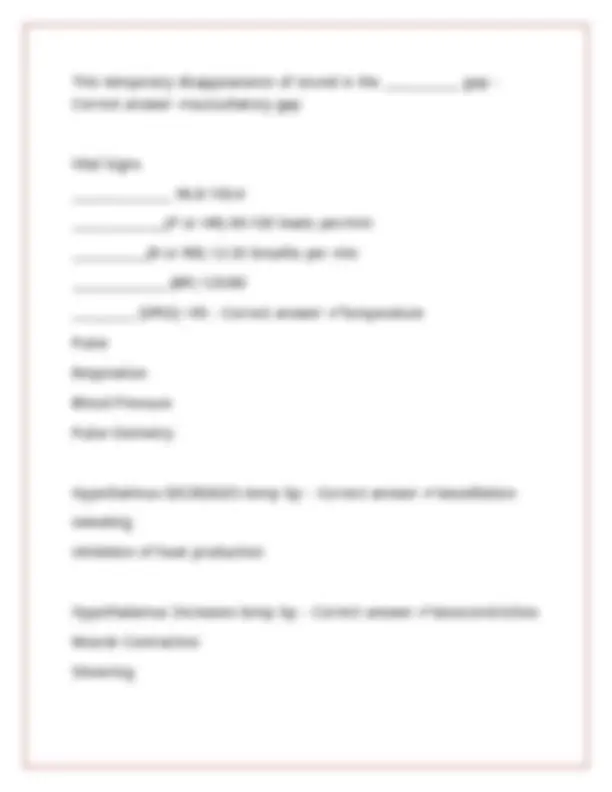
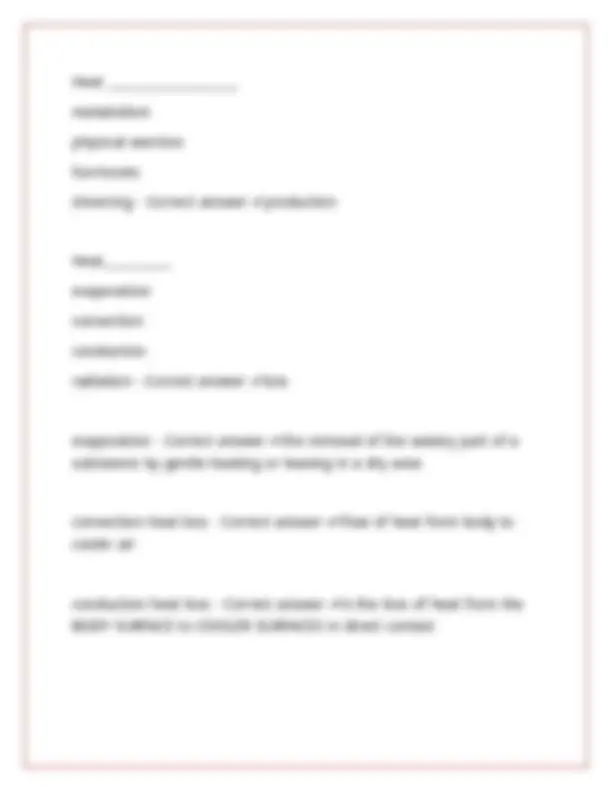
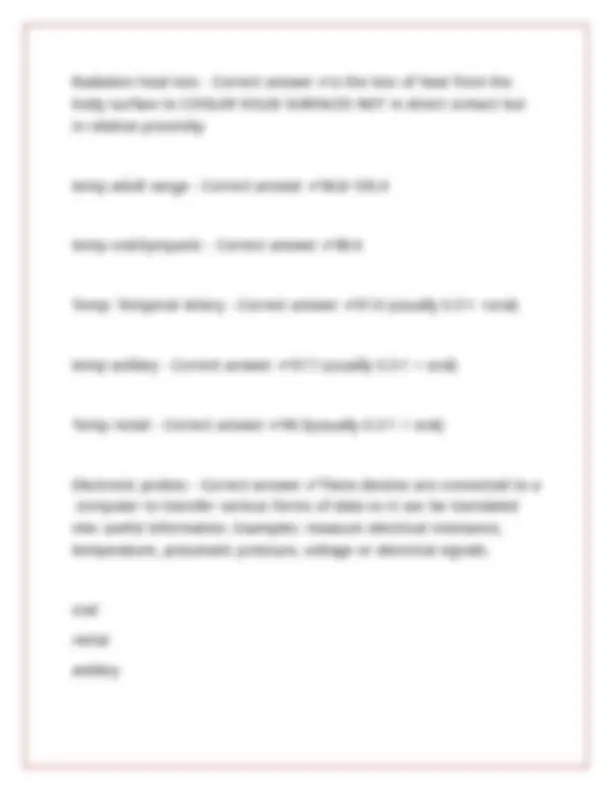
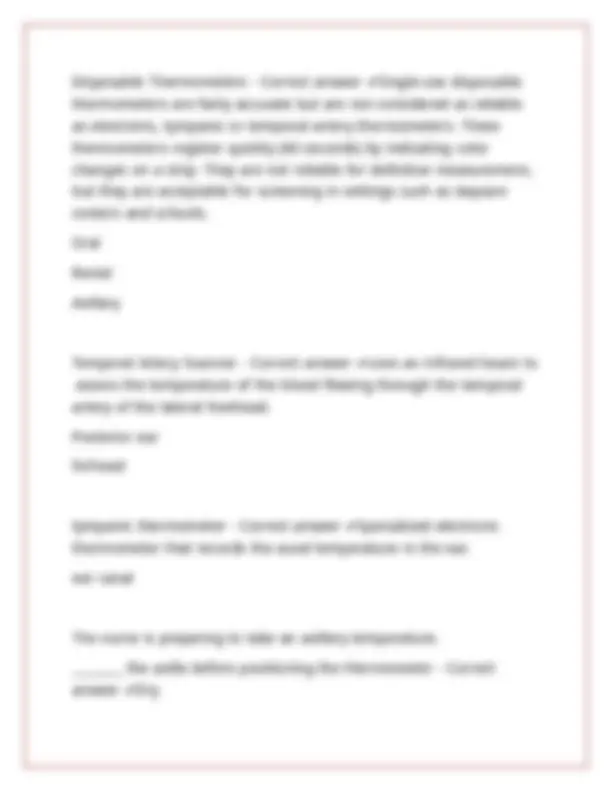
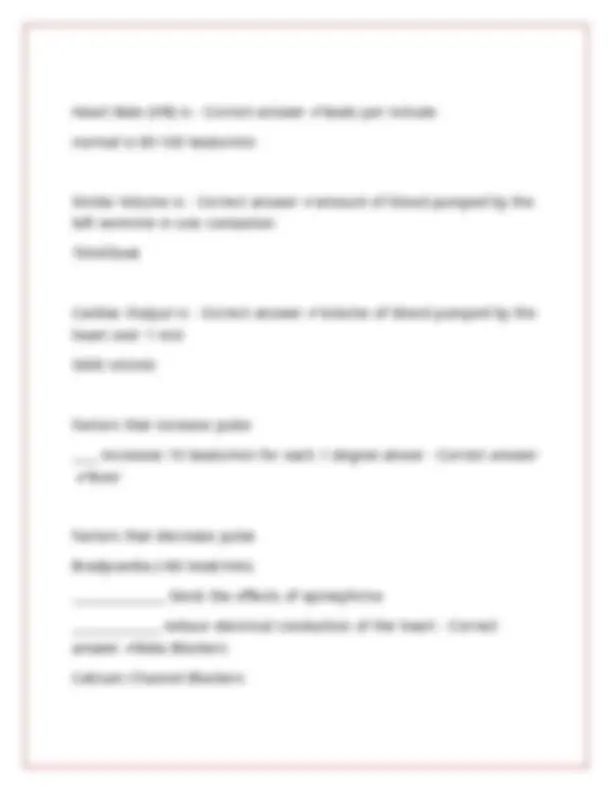

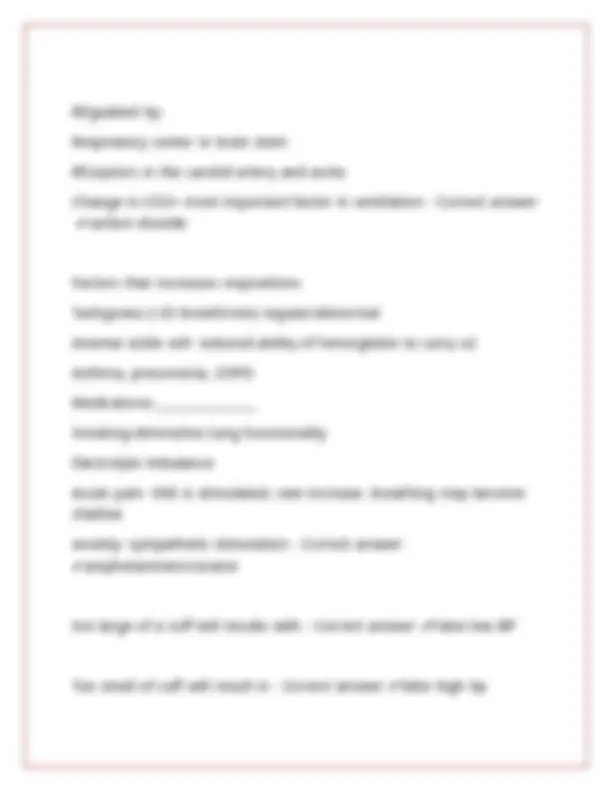


Study with the several resources on Docsity

Earn points by helping other students or get them with a premium plan


Prepare for your exams
Study with the several resources on Docsity

Earn points to download
Earn points by helping other students or get them with a premium plan
Community
Ask the community for help and clear up your study doubts
Discover the best universities in your country according to Docsity users
Free resources
Download our free guides on studying techniques, anxiety management strategies, and thesis advice from Docsity tutors
RNSG 1105 MODULE 7- VITAL SIGNS EXAM WITH VERIFIED SOLUTIONS
Typology: Exams
1 / 55

This page cannot be seen from the preview
Don't miss anything!
















































Why [] are [] vital [] signs [] important [] in [] a [] nursing [] assessment? [] - [] Correct [] answer [] ✔-VS [] are [] an [] important [] part [] of [] the [] nursing [] assessment [] in [] any [] clinical, [] setting, [] even [] if [] they [] are [] delegated, [] because [] a [] change [] in [] VS [] might [] indicate [] a [] change [] in [] health -Provides [] data [] to [] determine [] a [] PT's [] usual [] state [] of [] health [] (baseline) How [] often [] are [] vital [] signs [] assessed? [] - [] Correct [] answer [] ✔-Upon [] admission -Routine [] schedule [] based [] facility [] policy [] or [] HCP [] order -Anytime [] there [] is [] a [] change [] in [] PT [] condition -HCP [] orders [] a [] minimum [] frequency. [] Nurses [] job [] to [] judge [] weather [] more [] often [] is [] needed [] (from [] book) When [] is [] it [] important [] to [] measure [] vital [] signs? [] - [] Correct [] answer [] ✔- Before [] and [] After: Administration [] of [] medications [] that [] affect Respiratory [] or [] cardiovascular [] function Temperature-CTRL [] Fn's -Physical [] activities [] as [] appropriate
-Before, [] during, [] and [] after: Surgery [] or [] invasive [] diagnostic [] procedures Blood [] product [] transfusions What [] are [] the [] guidelines [] for [] measuring [] vital [] signs? [] - [] Correct [] answer [] ✔1-Assess [] & [] Select [] Appropriate [] equipment 2-Know: -baseline [] VS [] for [] the [] PT -Medications [] the [] PT [] is [] taking [] that [] may [] affect [] VS -Health [] history -Consider [] environmental [] factors
Testosterone What [] is [] the [] primary [] site [] of [] heat [] loss? [] - [] Correct [] answer [] ✔Skin What [] are [] the [] four [] mechanisms [] of [] heat [] loss? [] - [] Correct [] answer [] ✔Radiation Conduction Convection [] Evaporation What [] nursing [] measures [] are [] appropriate [] to [] maintain [] heat [] and [] promote [] heat [] lose? [] - [] Correct [] answer [] ✔-Maintain [] heat: [] remove [] wet [] clothes [] & [] replace [] w/ [] dry, [] warming [] blankets, [] drink [] hot [] liquids
-Environment -Temperature [] alterations What [] are [] the [] normal [] ranges [] for [] body [] temperature [] (oral, [] axillary, [] rectal)? [] - [] Correct [] answer [] ✔-Adult [] Range: [] 96.8-100.4 [] F -Average: Oral/tympanic- [] 98. Temporal- [] 97.6 [] Axillary- [] 97.7 [] Rectal- [] 99. What [] are [] sites [] and [] methods [] of [] assessing [] body [] temperature? [] - [] Correct [] answer [] ✔-Oral- [] Insert [] thermometer [] under [] the [] tongue [] in [] the [] posterior [] sublingual [] pocket Safety [] Alert- [] If [] PT [] ate, [] drank, [] chewed [] gum [] or [] smoked, [] wait [] 15-30 [] mins -Tympanic- [] Place [] into [] PTs [] ear [] canal [] while [] pulling [] pinna [] up [] and [] back Obtain [] core [] temperature Ear [] Wax [] does [] not [] affect [] temperature [] reading Safety [] Alert: [] DO [] NOT [] PERFORM [] on [] PTs [] who [] have [] drainage [] from [] the [] ear -Axillary- [] Place [] thermometer [] in [] the [] center [] of [] the [] wax -Rectal-Inserted [] lubricated [] thermometer [] into [] the [] rectum
Not [] for [] PTs [] who [] had [] oral [] surgery, [] trauma, [] history [] of [] epilepsy, [] or [] shaking [] chills Not [] for [] infants [] and [] small [] children, [] or [] PTs [] who [] are [] confused, [] unconscious, [] or [] uncooperative Risk [] of [] body [] fluid [] exposure, -Tympanic [] Advantage Easily [] accessible [] to [] site Minimal [] PT [] repositioning [] required Obtained [] w/o [] disturbing, [] waking, [] or [] repositioning [] PTs Used [] for [] PT [] w/ [] Tachypnea [] w/o [] affecting [] breathing Provides [] accurate [] core [] reading [] because [] eardrum [] close [] hypothalamus; [] sensitive [] to [] core [] temperature [] changes Very [] rapid [] measurement [] (2 [] to [] 5 [] seconds) Unaffected [] by [] oral [] intake [] of [] food [] or [] fluids [] or [] smoking Used [] in [] newborns [] to [] reduce [] infant [] handling [] and [] heat [] loss -Tympanic [] Disadvantage More [] variability [] of [] measurement [] than [] with [] other [] core [] temperature [] devices Requires [] removal [] of [] hearing [] aid [] before [] measurement Requires [] disposable [] sensor [] cover [] with [] only [] one [] size [] available Otitis [] media [] and [] cerumen [] impaction [] distorts [] readings Not [] used [] in [] PTs [] who [] have [] had [] surgery [] of [] the [] ear [] or [] tympanic [] membrane
Does [] not [] accurately [] measure [] core [] temperature [] changed [] during [] and [] after [] exercise Does [] not [] obtain [] continuous [] measurement Affected [] by [] ambient [] temperature [] devices [] such [] as [] incubators, [] radiant [] warmers, [] and [] facial [] fans When [] used [] in [] neonates, [] infants, [] and [] children [] 3 [] year [] old, [] use [] care [] to [] position [] device [] correctly [] because [] anatomy [] of [] ear [] canal [] makes [] it [] difficult [] to [] position Inaccuracies [] reported [] caused [] by [] incorrect [] positioning [] of [] handheld [] unit -Rectal- [] Advantage Sometimes [] considered [] to [] be [] more [] reliable [] whe What [] is [] best [] for [] infants [] and [] children? [] - [] Correct [] answer [] ✔tympanic- [] children [] like [] this [] because [] it [] only [] takes [] a [] few [] seconds What [] is [] a [] peripheral [] pulse [] meeting? [] - [] Correct [] answer [] ✔- [] pulse [] that [] can [] be [] felt [] the [] periphery [] of [] the [] body [] by [] palpating [] an [] artery [] over [] a [] bony [] prominence -Example- [] Are [] carotid, [] radial, [] and [] popliteal [] pulses What [] is [] stroke [] volume [] and [] cardiac [] output [] and [] their [] relationship [] to [] a [] pulse? [] - [] Correct [] answer [] ✔-CO=HR [] x [] SV
-Equality: [] pulse [] in [] one [] extremity [] is [] sometimes [] unequal [] in [] strength. [] So [] measure [] both [] sides [] simultaneously. What [] are [] sites [] and [] methods [] of [] assessing [] the [] pulse? [] - [] Correct [] answer [] ✔PalpationMiddle [] two [] - [] three [] fingers [] usedPads [] on [] fingers [] are [] sensitive [] areas [] for [] detecting [] a [] pulse AuscultationStethoscope [] used [] for [] auscultatingan [] apical [] pulse Doppler [] Ultrasound [] - [] Used [] to [] hear [] pulses [] that [] are [] difficult [] to [] palpate [] or [] auscultate. How [] long [] would [] the [] nurse [] assess [] an [] apical [] pulse? [] - [] Correct [] answer [] ✔Is [] the [] rate [] is [] regular, [] count [] for [] 30 [] sec [] and [] multiple [] by [] 2. [] If [] rate [] is [] irregular. [] Count [] for [] full [] 60 [] sec. What [] factors [] that [] affect [] respiratory [] rate, [] depth, [] and [] movement? [] - [] Correct [] answer [] ✔- [] exercise, [] acute [] pain, [] anxiety, [] smoking, [] body [] position, [] medications, [] neurological [] injury, [] and [] hemoglobin [] function What [] are [] normal [] ranges [] for [] rate [] of [] respirations? [] - [] Correct [] answer [] ✔RateNormal [] adult [] rate [] is [] 12-20 [] BPM AbnormalTachypnea [] - [] increased [] rate [] >24 [] BPM Bradypnea [] - [] decreased [] rate [] < [] 12 [] BPM
How [] does [] the [] nurse [] describe [] depth [] and [] rhythm [] of [] respirations? [] - [] Correct [] answer [] ✔-Depth-deep, [] shallow, [] normal, [] or [] labored -Rhythm: [] regular [] or [] irregular DepthDegree [] of [] movement [] in [] the [] chest [] wallDescribed [] as [] normal, [] deep, [] or [] shallow Normal [] inspiration [] and [] expiration [] or [] volume [] of [] air [] exchanges [] with [] each [] breath [] in [] an [] adult [] is [] about [] 500 [] ml. [] of [] air. [] This [] in [] know [] as [] tidal [] volume Rhythm:Regularity [] of [] expirations [] and [] inspirations Normally, [] they [] are [] evenly [] spaced [] in [] an [] adult. Normally, [] irregular [] in [] an [] infant Irregular [] respirations [] in [] an [] adult [] should [] be [] reported. What [] are [] the [] terms [] used [] to [] document [] slow [] respirations [] and [] fast [] respirations? [] - [] Correct [] answer [] ✔-Bradypnea- [] is [] slow [] respiration [] -Tachypnea- [] is [] fast [] respiration What [] are [] the [] patterns [] of [] respiration? [] - [] Correct [] answer [] ✔-Bradypnea- [] Rate [] of [] breathing [] is [] regular [] but [] abnormally [] slow [] (les [] than [] 12 [] breaths/min) -Tachypnea- [] Rate [] of [] breathing [] is [] regular [] but [] abnormally [] rapid [] (greater [] than [] 20 [] breaths/min)
-Pulse [] pressure- [] systolic- [] diastolic [] pressure What [] are [] factors [] influencing [] blood [] pressure? [] - [] Correct [] answer [] ✔-Age, [] stress, [] ethnicity [] & [] genetics, [] gender, [] daily [] variations, [] medications, [] activity [] & [] weight, [] smoking What [] is [] considered [] a [] normal [] blood [] pressure? [] - [] Correct [] answer [] ✔NORMAL: [] <120 [] systolic<80 [] diastolic What [] is [] the [] difference [] in [] prehypertension, [] hypertension, [] and [] hypotension? [] - [] Correct [] answer [] ✔prehypertension:120-139 [] or [] 80- hypertension [] 140and [] > [] or [] 90 [] and [] > What [] equipment [] is [] used [] to [] assess [] blood [] pressure? [] - [] Correct [] answer [] ✔Sphygmomanometer [] & [] stethoscope [] w/ [] auscultation. [] Or [] automated [] oscillometric [] device [] w/out [] auscultation. What [] is [] method/procedure [] for [] assessing [] a [] brachial [] artery [] blood [] pressure? [] - [] Correct [] answer [] ✔-hand [] hygiene -Positions [] PT
-place [] stethscope [] in [] ears -Relocate [] artery [] and [] place [] chest [] piece [] is [] stethoscope [] over [] it -Continue [] to [] deflate, [] nothing [] when [] sounds [] disappear. [] The [] diastolic [] pressure
d.Adolescent [] waking [] from [] sleep e.Three-pack-per-day [] smoker [] with [] pneumonia [] - [] Correct [] answer [] ✔a.Patient [] just [] admitted [] with [] four [] rib [] fractures b.Woman [] who [] is [] 9 [] months' [] pregnant c.Three-pack-per-day [] smoker [] with [] pneumonia (Patient [] with [] rib [] fractures [] is [] unlikely [] to [] breathe [] deeply [] and [] a [] large [] fetus [] restricts [] diaphragmatic [] movement, [] leading [] to [] decreased [] ventilatory [] volume. [] Pneumonia [] decreases [] gas [] exchange [] surface [] area. [] Tachypnea [] occurs [] to [] increase [] minute [] ventilation. [] Alcohol [] is [] a [] respiratory [] depressant.) As [] you [] are [] obtaining [] the [] oxygen [] saturation [] on [] a [] 19-year-old [] college [] student [] with [] severe [] asthma, [] you [] note [] that [] she [] has [] black [] nail [] polish [] on [] her [] nails. [] You [] remove [] the [] polish [] from [] one [] nail, [] and [] she [] asks [] you [] why [] her [] nail [] polish [] had [] to [] be [] removed. [] What [] is [] the [] best [] response? a.Nail [] polish [] attracts [] microorganisms [] and [] contaminates [] the [] finger [] sensor. b.Nail [] polish [] increases [] oxygen [] saturation. c.Nail [] polish [] interferes [] with [] sensor [] function. d.Nail [] polish [] creates [] excessive [] heat [] in [] the [] sensor [] probe. [] - [] Correct [] answer [] ✔c.Nail [] polish [] interferes [] with [] sensor [] function.
(The [] pigment [] in [] black [] nail [] polish [] affects [] light [] absorption [] and [] reflection.) A [] 52-year-old [] woman [] is [] admitted [] with [] dyspnea [] and [] discomfort [] in [] her [] left [] chest [] with [] deep [] breaths. [] She [] has [] smoked [] for [] 35 [] years [] and [] recently [] lost [] over [] 10 [] lbs. [] Her [] vital [] signs [] on [] admission [] are: [] HR [] 112, [] BP [] 138/82, [] RR [] 22, [] tympanic [] temperature [] 36.8° [] C [] (98.2° [] F), [] and [] oxygen [] saturation [] 94%. [] She [] is [] receiving [] oxygen [] at [] 2 [] L [] via [] a [] nasal [] cannula. [] Which [] vital [] sign [] reflects [] a [] positive [] outcome [] of [] the [] oxygen [] therapy? a. [] Temperature: [] 37° [] C [] (98.6° [] F) b.Radial [] pulse: [] 112 c.Oxygen [] saturation: [] 96% d.Blood [] pressure: [] 134/ e.Respiratory [] rate: [] 24 [] - [] Correct [] answer [] ✔c.Oxygen [] saturation: [] 96% (Oxygen [] saturation [] is [] an [] assessment [] of [] oxygen [] perfusion. [] Respiratory [] rate [] assesses [] ventilation, [] radial [] pulse [] and [] blood [] pressure, [] assess [] the [] cardiovascular [] system, [] and [] temperature [] is [] an [] assessment [] of [] thermal [] regulation.) A [] patient [] is [] admitted [] for [] dehydration [] caused [] by [] pneumonia [] and [] shortness [] of [] breath. [] He [] has [] a [] history [] of [] heart [] disease [] and [] cardiac [] dysrhythmias. [] The [] nursing [] assistant [] reports [] his [] admitting [] vital [] signs [] to [] the [] nurse. [] Which [] measurements [] should [] the [] nurse [] reassess? a. [] Right [] arm [] BP: [] 118/ b. [] Radial [] pulse [] rate: [] 72 [] and [] irregular
g.Compare [] right [] and [] left [] radial [] pulses [] for [] strength [] - [] Correct [] answer [] ✔a. [] Repeat [] the [] measurements [] on [] both [] arms [] using [] a [] stethoscope e. [] Verify [] that [] the [] correct [] cuff [] size [] was [] used [] during [] the [] measurements (The [] systolic [] BP [] measurements [] are [] significantly [] different [] and [] may [] reflect [] the [] vascular [] and [] muscular [] changes [] caused [] by [] the [] stroke. [] However, [] unexpected [] findings [] require [] reassessment [] by [] the [] nurse [] with [] a [] comparison [] to [] previous [] values. [] It [] is [] premature [] to [] notify [] the [] provider; [] differences [] are [] not [] caused [] by [] medications; [] inappropriate [] cuff [] size [] would [] reflect [] similar [] systolic [] pressures; [] pulse [] strength [] would [] be [] similar [] for [] these [] BP [] measurements.) A [] patient [] has [] been [] admitted [] for [] a [] cerebrovascular [] accident [] (stroke). [] She [] cannot [] move [] her [] right [] arm, [] and [] she [] has [] a [] right-sided [] facial [] droop. [] She [] is [] able [] to [] eat [] with [] her [] dentures [] in [] place [] and [] swallow [] safely. [] The [] nursing [] assistive [] personnel [] (NAP) [] reports [] to [] you [] that [] the [] patient [] will [] not [] keep [] the [] oral [] thermometer [] probe [] in [] her [] mouth. [] What [] direction [] do [] you [] provide [] to [] the [] NAP? a. [] Direct [] the [] NAP [] to [] hold [] the [] thermometer [] in [] place [] with [] her [] gloved [] hand b. [] Direct [] the [] NAP [] to [] switch [] the [] thermometer [] probe [] to [] the [] left [] sublingual [] pocket c. [] Direct [] the [] NAP [] to [] obtain [] a [] right [] tympanic [] temperature D. [] Direct [] the [] NAP [] to [] use [] a [] temporal [] artery [] thermometer [] from [] right [] to [] left [] - [] Correct [] answer [] ✔D. [] Direct [] the [] NAP [] to [] use [] a [] temporal [] artery [] thermometer [] from [] right [] to [] left
(A [] temporal [] artery [] temperature [] verifies [] the [] forehead [] temperature [] in [] back [] of [] the [] left [] ear, [] which [] is [] the [] side [] not [] affected [] by [] the [] altered [] blood [] flow [] related [] to [] the [] stroke. [] Holding [] the [] thermometer [] or [] switching [] locations [] will [] not [] help [] the [] patient [] close [] her [] mouth [] during [] temperature [] assessment. [] The [] patient's [] right [] side [] has [] vascular [] changes [] related [] to [] the [] stroke.) A [] healthy [] adult [] patient [] tells [] the [] nurse [] that [] he [] obtained [] his [] blood [] pressure [] in [] "one [] of [] those [] quick [] machines [] in [] the [] mall" [] and [] was [] alarmed [] that [] it [] was [] 152/72 [] when [] his [] normal [] value [] ranges [] from [] 114/72 [] to [] 118/78. [] The [] nurse [] obtains [] a [] blood [] pressure [] of [] 116/76. [] What [] would [] account [] for [] the [] blood [] pressure [] of [] 152/92? A. [] cuff [] to [] small b. [] Arm [] positioned [] above [] heart [] level c. [] The [] insufficient [] time [] between [] measurements d. [] Slow [] inflation [] of [] the [] cuff [] by [] the [] machine e. [] Patient [] did [] not [] remove [] his [] long-sleeved [] shirt [] - [] Correct [] answer [] ✔A. [] cuff [] to [] small c. [] Insufficient [] time [] between [] measurements (Using [] too [] small [] of [] a [] cuff [] and [] not [] allowing [] for [] insufficient [] time [] between [] measurements [] will [] result [] in [] false-high [] readings. [] Arm [] above [] heart [] level [] and [] slow [] inflation [] result [] in [] false [] low [] readings.) Which [] patient [] is [] at [] highest [] risk [] for [] tachycardia?